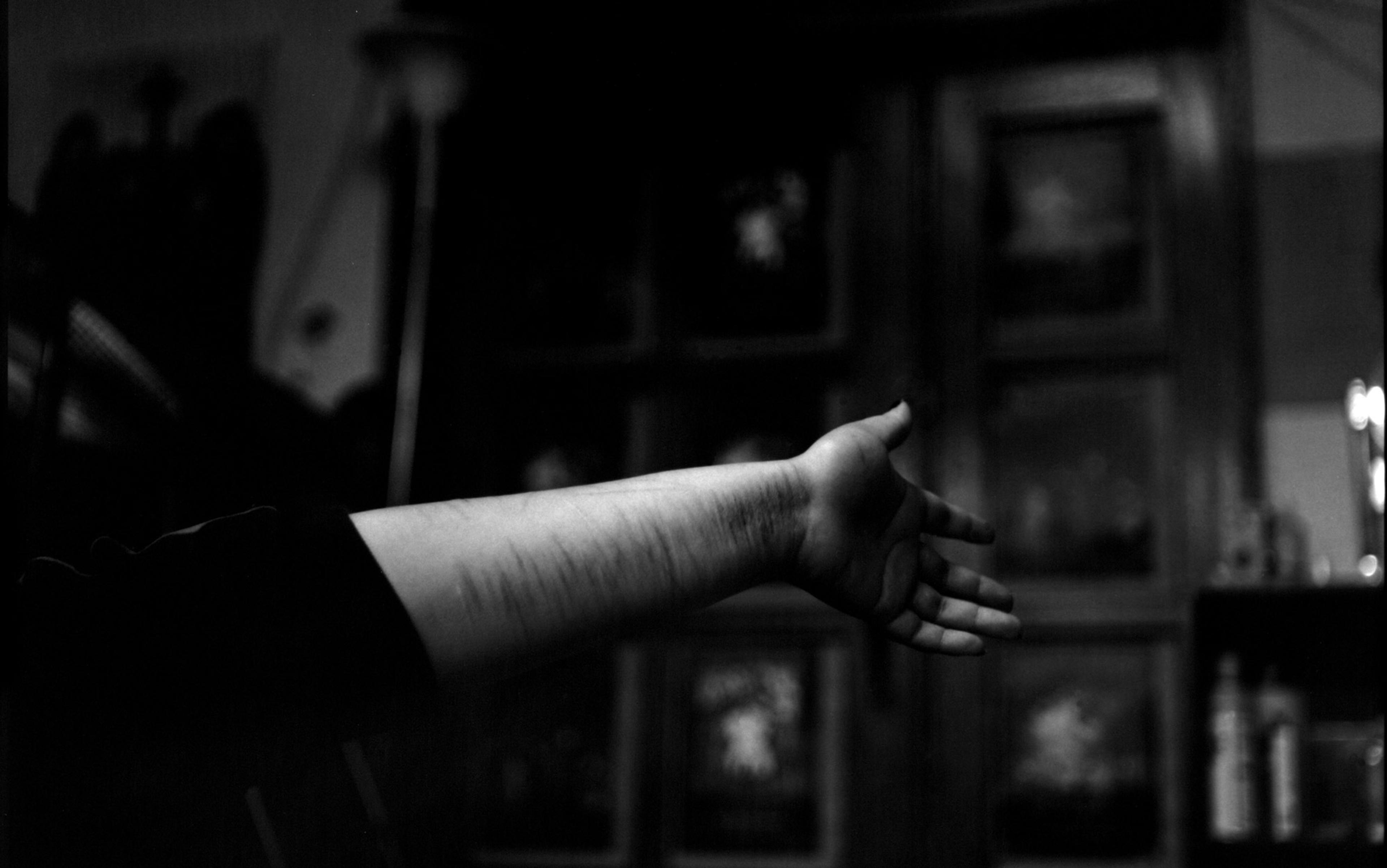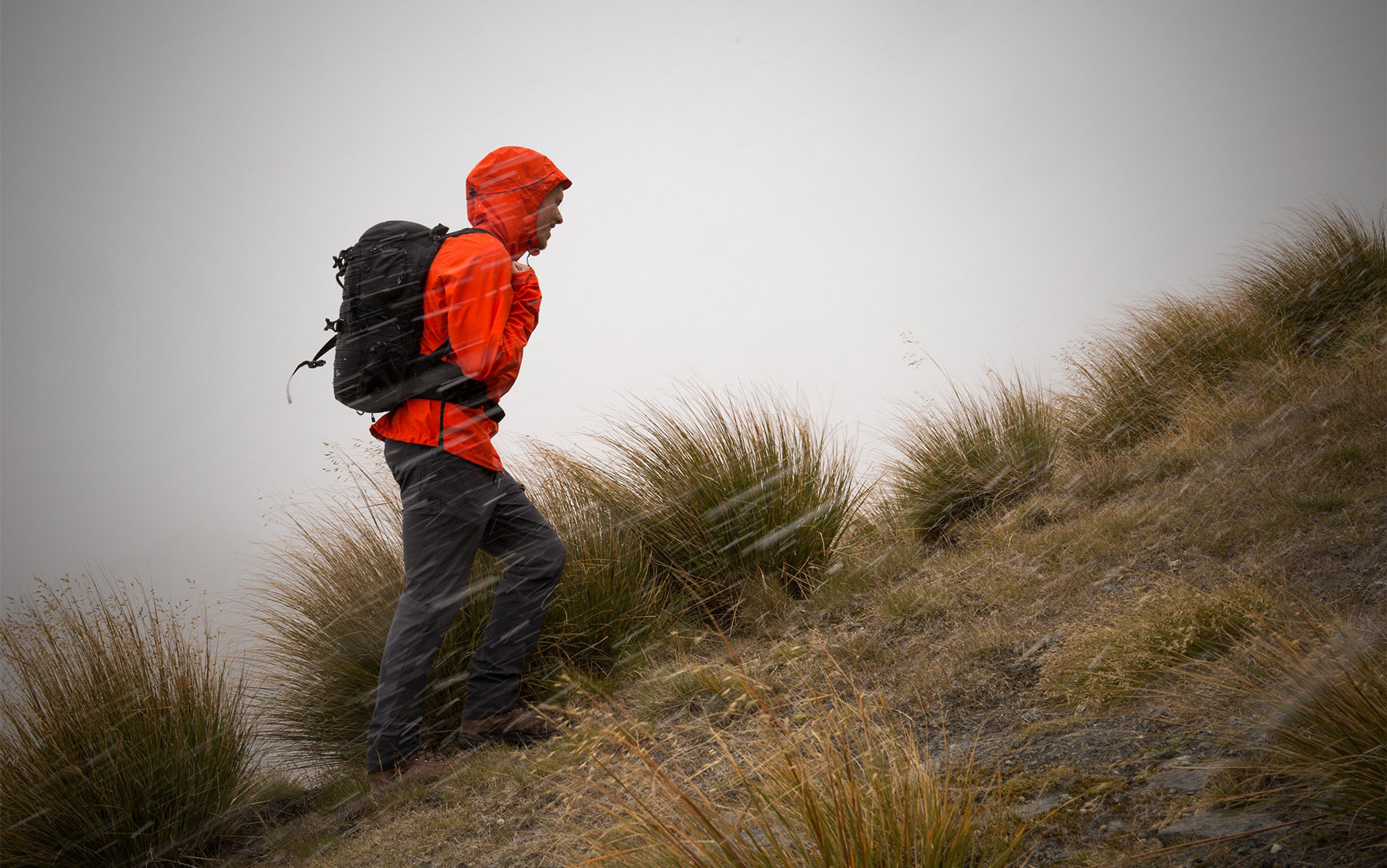Here’s what I remember about the first time I cut myself: I was mad. As a writer, I wish I could come up with something more literary, such as: ‘The cuts provided a route through my skin for the emotions to escape.’ Or maybe: ‘I used it to translate emotional pain into physical pain.’ Or even, perhaps: ‘I engraved my suffering into my skin, turmoil writ large for all the world to see.’
These are, to some extent, true. But that’s not what I was thinking the first time I picked up a pair of scissors and slashed at my thighs. Mostly, I was pissed off.
I had argued with my mom over something so banal it has long since disappeared into the dustbin of memory. And, in a fit of adolescent fury, I stormed into my bedroom and slammed the door. Blind with rage, I picked up a pair of scissors and turned them over in my hand. The next thing I knew, I was staring at tiny pearls of blood on my leg. The fog of anger had lifted.
I quickly patched myself up, rather shamefaced. The scissors were old and the blades were dull, so I had done minimal physical damage. Then or now, I couldn’t explain what had come over me. I vowed never to do it again. Within two weeks, I had broken that vow.
Over the years, I’ve tried to explain self-injury to my therapists, my parents, my friends and, most recently, my husband. Everyone has the same plaintive question: ‘Why?’ Mostly, I just shrug my shoulders and mutter: ‘Dunno.’ I don’t tell them that I am asking the same question of myself. I don’t enjoy the process, nor do I like the scars. It’s shameful and embarrassing. I desperately wanted to stop, but one thing kept getting in my way: after I cut, I felt better.
Although I have written extensively about my mental health history – I have a psychiatric rap sheet that stretches as long as my arm – I rarely mention self-injury. Depression, anxiety, anorexia, even suicide attempts – all of those feel infinitely more explicable than the recurrent pull of the razor. I am not alone in my shame or my struggles. A 2006 study in Pediatrics estimates that nearly one in five college students have deliberately injured themselves at least once. Approximately six per cent of young adults will injure themselves repeatedly. Although death caused directly by self-injury is relatively rare, even occasional self-harm dramatically increases the risk of suicide attempts and completed suicides.
Why so many of us keep hitting the self-destruct button still isn’t clear, but a new era of studies in psychology and neuroscience offer a richer picture of why, for some of us, feeling bad means feeling good.
Blood is a powerful force. We speak of blood ties and land that has been consecrated by blood. We spill blood to cure disease and to appease gods. Long-standing disputes between groups of people become blood feuds. Blood – and the injuries sustained to obtain it – has long been a symbol of both war and religion. Christians drink wine during Holy Communion that represents the blood of Christ, which was spilt to redeem our sins. Mayan priests opened their own veins for a blood sacrifice for their deities.
Self-mutilation is just as ancient. The historian Herodotus writes of the first King Cleomenes of Sparta, who went insane and was placed in the stocks in the fifth century BCE:
As he was lying there, fast bound, he noticed that all his guards had left him except one. He asked this man, who was a serf, to lend him his knife. At first the fellow refused, but Cleomenes, by threats of what he would do to him when he recovered his liberty, so frightened him that he at last consented. As soon as the knife was in his hands, Cleomenes began to mutilate himself, beginning on his shins. He sliced his flesh into strips, working upwards to his thighs, hips, and sides until he reached his belly, which he chopped into mincemeat.
The first clinical reports of what would now be recognised as self-injury appeared in the late 1800s, in Anomalies and Curiosities of Medicine (1896) by the American physicians George Gould and Walter Pyle. They write of ‘needle girls’, young women who repeatedly injured themselves by inserting sewing needles and pins into their skin, or otherwise cutting themselves. They summarise the case of one 30-year-old woman from New York like this:
On September 25th she cut her left wrist and right hand; in three weeks she became again ‘discouraged’ because she was refused opium, and again cut her arms below the elbows, cleanly severing the skin and fascia, and completely hacking the muscles in every direction. Six weeks later, she repeated the latter feat over the seat of the recently healed cicatrices [cut marks]… Five weeks after convalescence, during which her conduct was exemplary, she again cut her arms in the same place. In the following April, for the merest trifle, she again repeated the mutilation, but this time leaving pieces of glass in the wounds. Six months later she inflicted a wound seven inches in length, in which she inserted 30 pieces of glass, seven long splinters, and five shoe-nails. In June 1877, she cut herself for the last time. The following articles were taken from her arms and preserved: 94 pieces of glass, 34 splinters, two tacks, five shoe-nails, one pin, and one needle, besides other things which were lost – making altogether about 150 articles.
Gould and Pyle classified this ritualistic self-harm as a form of hysteria, and the women who engaged in it as deceitful and attention-seeking. In fact, until the early 2000s, most of the clinical literature classified self-injury with more severe psychiatric disorders such as psychosis and borderline personality disorder, a state of inner chaos and instability, especially where relationships are concerned.
‘Some women who self-injured were hospitalised every time they cut themselves, which could be hundreds of times over their lifetime. They essentially lived in hospitals,’ said Wendy Lader, the clinical director of a US self-abuse programme and one of the first psychologists to treat self-injury. ‘People thought I was crazy when I said that many of these people could be treated as outpatients because they weren’t necessarily suicidal.’
‘These were amazing, bright, intelligent young people that had so much promise, only they were consumed by thoughts of hurting themselves’
Lader first began to study and treat self-injury in the early 1980s after her colleague Karen Conterio began seeing evidence of more and more women self-harming in her outpatient substance-abuse practice. None of these women showed signs of psychosis or personality disorders, nor were they cutting or burning themselves with any intent of suicide. Conterio thought she was seeing just the tip of the iceberg, and so she placed an ad in the Chicago Tribune in 1984 asking to hear from those who regularly hurt themselves without intending to commit suicide. Mail poured in, and people suddenly began talking about self-injury. Its emergence as a pop-culture phenomenon led to an appearance on the Phil Donahue TV show in 1985 with several women who self-harmed.
In 1986, Lader and Conterio founded what would become SAFE (Self-Abuse Finally Ends) Alternatives, the world’s first residential facility specifically to treat women who self-injured, now located outside St Louis. Psychologists generally believed that Lader and Conterio were seeing a rare subset of the population, and that the psyches of these women were as hopelessly scarred as their bodies. Lader wasn’t convinced. ‘These were amazing, bright, intelligent young people that had so much promise, only they were consumed by thoughts of hurting themselves,’ Lader told me.
Though others doubted it, Lader also believed that self-harm was far more common than anyone realised. Proof finally arrived in 2002 from Nancy Heath, a psychologist at McGill University in Canada, and her PhD student Shana Ross. At her placement in a local high school, Ross was regularly talking to teens who expressed concern about their own or a friend’s self-injury. When she discussed making this the focus of her dissertation, Heath tried to talk her out of it.
‘I told her she would never find enough people who self-harmed to get the data for a thesis,’ Heath told me. ‘I finally agreed to let her try.’
Ross’s preliminary results indicated that more than one in five young people had self-injured at least once. This shocked Heath and the rest of the dissertation committee so much that they thought the high-school students had misunderstood the question. So Ross went back to the drawing board, conducting in-depth interviews with those who had reported self-injury and throwing out all the results with even a hint of inconsistency. The percentages dropped, but Ross was still left with a mindbogglingly high number of adolescents reporting self-harm: 13.9 per cent.
Not long after Ross and Heath’s study appeared in the Journal of Youth and Adolescence, Janis Whitlock, a psychologist at Cornell University, published a study of self-injury among 5,000 students at several Ivy League universities. Her results showed similarly high numbers of young people who had harmed themselves: 20 per cent of women and 14 per cent of men said they had self-injured at least once.
‘I was just shocked. Everyone was finding really high rates,’ Whitlock told me. ‘The issue seemed to come out of nowhere.’
What was groundbreaking about these two studies was not just the high rates of self-injury but that these were community populations, and not people hospitalised for psychiatric problems. They were the people you sat next to in class and stood in line with at the grocery store.
All these findings meant that self-injury had to be redefined. By 2006, a small cadre of scientists at the first meeting of the International Society for the Study of Self-Injury (ISSS) did just that. ‘We discussed the definition over dinner and drinks one night,’ Heath told me. ‘It meant the poor waiter had to listen to the most disturbing dinner conversation of his life. We asked each other questions like, “So if removing your own eyeball is self-harm, what about drinking bleach?”’
The definition they developed still stands: non-suicidal self-injury is the deliberate, self-inflicted destruction of body tissue without suicidal intent nor for socially sanctioned purposes such as piercings or tattoos. Epidemiological studies found that, while up to a third of all adolescents had deliberately harmed themselves at least once, fewer than one in 10 adolescents and young adults repeatedly did so. Moreover, although many pop culture accounts report self-injury to be a ‘female’ thing, studies have found that males and females self-injure in roughly equal proportions.
The group is heterogeneous. Many struggle with depression, anxiety, and eating disorders. Some meet criteria for borderline personality disorder. Yet others have autism spectrum disorders or, like me, associated anxiety disorders; this last group spent the most time thinking about self-injury before engaging in self-harm, and had the highest risk of suicide.
In fact, cutting and other forms of bodily self-harm are among the most robust predictors of future suicidal behaviour, says Stephen Lewis, a psychologist at the University of Guelph in Ontario. Lewis and others believe that self-harm signals the inability to cope with emotions at hand. The temporary escape that self-injury provides could be a precursor to the more permanent escape of suicide.
Regardless of the reasons that suicide and self-harm are so strongly linked, researchers still struggled to understand why people would repeatedly (and deliberately) hurt themselves. Matthew Nock, now a professor of psychology at Harvard, tried to figure this out while he was a PhD student at Yale under the psychologist Mitch Prinstein (who is now at the University of North Carolina at Chapel Hill). By delving into the literature on other repetitive behaviours and asking individuals who self-injured to keep diaries, Nock and Prinstein developed the Four Factor Model in 2004.
The model works through positive and negative reinforcement, Prinstein told me. Positive reinforcement is when doing something gives us a reward; negative reinforcement is the removal of something that makes us feel bad. Self-injury offers both positive and negative reinforcement, both for intrapersonal reasons (by altering emotions) and for interpersonal reasons (by altering our relationships with others). Someone who is so numbed by depression that she feels nothing might cut herself to feel something, anything, even if it’s pain – an example of positive reinforcement for intrapersonal reasons. Others might be anxious or enraged and hurt themselves to diminish those feelings, which is a case of intrapersonal negative reinforcement. Still others could injure themselves to demonstrate how distressed they and to get loved ones to react (interpersonal positive reinforcement) or to stop doing something (interpersonal negative reinforcement). A person’s reasons for self-injury can be different each time, and can encompass a variety of motivations, but some are more common than others.
‘By far the most common reason people said they self-injured was to stop feeling so bad,’ Prinstein said.
I could relate to that. Intense, negative emotions I didn’t know how to manage always preceded an episode of self-injury. Sometimes, the goal was to feel better. Other times, the desire to turn down the volume on emotions such as anger or anxiety was tinged with an urge to punish myself. I deserved to hurt, I deserved to feel pain and have scars so that the world would know I was a horrid person. Not everyone, however, reported feeling pain while hurting themselves; a substantial portion of people who self-injure say that their actions don’t result in immediate pain.
those with the greatest difficulties in regulating and responding to emotions were also able to withstand the pain the longest
All this led Joseph Franklin, who received his PhD under Prinstein and is currently a postdoc in Nock’s lab, to ask whether differences in pain perception might contribute to self-injury. He brought 25 individuals who regularly self-harmed into the lab and asked them to place their hands in ice-cold water, a common way to measure pain.
Compared against 47 controls, the individuals who self-harmed were able to leave their hands in the ice-cold water longer, indicating a diminished pain perception. Franklin also found that those with the greatest difficulties in regulating and responding to emotions were also able to withstand the pain the longest. It was as if their emotional pain was distracting them from the physical pain.
A related study by Nock and colleagues at Harvard showed that self-criticism also increased the amount of time for which individuals who self-injured could withstand pain. Franklin believes that people who are overly self-critical might push themselves to endure the pain for longer. These two factors – emotion regulation and self-criticism – seem to be independent, and their appearance together would likely increase any risk of self-injury even further.
This finding hit home with me. Some of my worst periods of cutting occurred after struggles in graduate school, whether it was difficulty completing my thesis, a bad grade on an exam, or just generally feeling not good enough. I wallowed in self-hatred. Experts would likely say that my feeling I deserved the pain, or had somehow earned it through my behaviour, made it easier to tolerate.
One issue bothering Franklin and others involved the barriers to self-harm. ‘If we all feel so much better when pain stops, the question isn’t why so many people self-injure, it’s why so few people do,’ Franklin said.
But recent unpublished experiments reveal that most people have a powerful aversion to mutilating their bodies. When they see pictures of bodily harm, they look away: it’s profoundly unpleasant. That wasn’t the case with those who self-harmed. When these people looked at such images, eye-tracking software revealed that they were drawn to them – probably a significant factor in keeping the disorder in place.
Yet cutters such as me didn’t self-harm to deal with physical pain. We hurt ourselves to cope with emotional pain. Neuroscience is showing how these two factors intertwine. When we get dumped by a romantic partner, we are heartbroken. Anxiety winds us up and leaves us ready to snap. Rage clenches our fists in hate. Emotions are psychological, but they are also physical. When it comes to sensing physical and emotional pain, our brains use the same two areas: the anterior insula, a small patch of neural real estate that’s part of the cerebral cortex behind each ear, and the anterior cingulate cortex, a hook-shaped piece of brain tissue towards the front of the brain. These are the areas in the brain that process pain, regardless of whether we’ve felt the sting of rejection or the sting of a bee.
Pain relievers also act on these two areas, regardless of whether someone is experiencing emotional or physical pain. A 2010 study in Psychological Science revealed that the pain relievers such as Tylenol or paracetamol (acetaminophen) helped to relieve the distress associated with social rejection and also decreased activity in the anterior insula and the anterior cingulate cortex. This doesn’t mean that Tylenol is the next Prozac, but it does show just how intertwined emotional and physical pain are in the brain.
‘If you’re feeling emotionally hurt, those two parts of the brain are aroused,’ Whitlock told me. ‘Among people who self-injure, the experience is very acute. So while rejection might make me feel bad, it makes someone who self-injures feel overwhelmingly bad.’
Far from being the quasi-poetic gestures of a wannabe writer, my self-injury was actually the sign of signal-scrambling in my brain
And the fact that physical and emotional pain perceptions use many of the same neural circuits provides those who self-harm with a curious ‘out’. They’ve learned that, while the pain peaks with self-injury, it then comes down the other side. The physical pain lessens – as does the emotional pain.
It was this link that kept me coming back for more. I didn’t enjoy the pain of cutting but, as the physical pain began to fade, it took some of my emotional distress with it. Far from being the quasi-poetic gestures of a wannabe writer, my self-injury was actually the sign of signal-scrambling between my anterior insula and anterior cingulate cortex. The problem was that the embarrassment of cutting, the knowledge that these marks would become permanently tattooed into my skin, and the fears that someone would discover my secret, meant that any relief was short-lived. All too soon, I was feeling worse than before, leaving me vulnerable to repeat episodes of psychic pain, followed by even more cutting.
So much attention has been paid to young cutters, but what happens to those who self-injure over time? No one really knows. Treatments remain sparse. The most widely used, dialectical behaviour therapy (DBT), encourages people to change their behaviour first, with thought patterns to follow. At the heart of DBT is the Buddhist-like belief that an individual is doing the best that she can and striving to do better, yet clinical trials have shown mixed results. Part of the problem is that borderline personality disorder, the original target for DBT, is generally a more permanent state, where self-injury waxes and wanes, making it harder to determine how well the therapy works.
‘It’s really crazy-making for parents and loved ones because they’ll think a person is out of the woods or has stopped, and then something happens and it starts all over again,’ Whitlock told me.
It has been several years since I last cut myself. Although the urges get easier to resist, when I’m under high stress, thoughts of hurting myself return. I have learned to distance myself from these thoughts, to treat them as comments from the random peanut gallery in my head rather than concrete advice from a reputable source. Similar techniques have been used to treat anxiety disorders such as obsessive-compulsive disorder (with which I have also been diagnosed). In fact, these therapies have helped to shape my brain to work in a healthier pattern. With lots of therapy, I have learned that emotions pass and I can cope with them in ways that don’t leave me embarrassed, ashamed and scarred.
It’s hard not to press the self-destruct button, especially when I know it provides a few moments of blessed relief. It’s hard to live alongside these urges and not give in. But, eventually, self-harm has become just one of a panoply of options at my fingertips. My blood remains inside, my skin intact. My scars have begun to heal.
This Essay is provided as general information only. It is not a substitute for independent, professional medical or health advice tailored to your specific circumstances. If you are struggling with psychological difficulties, we encourage you to seek help from a professional source.






